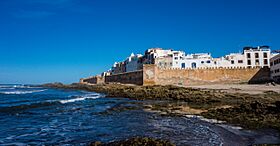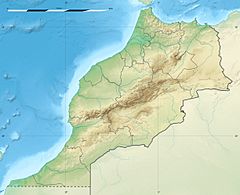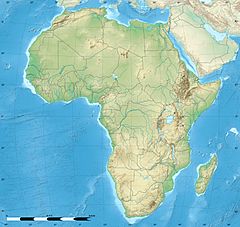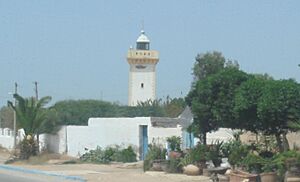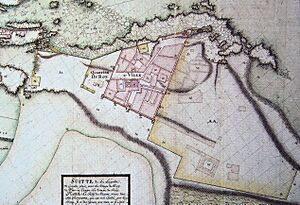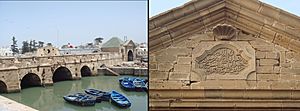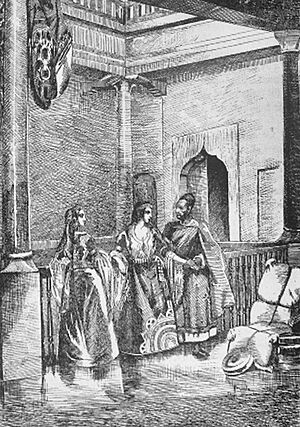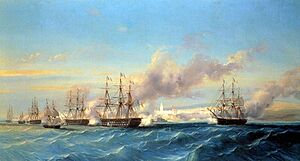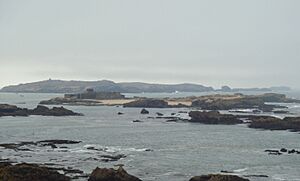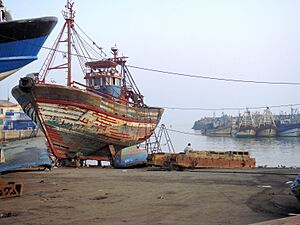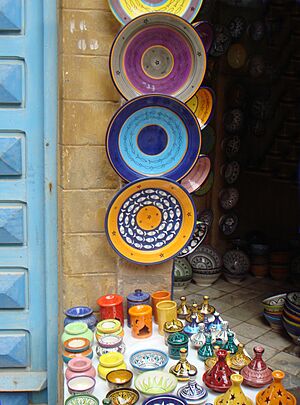Essaouira facts for kids
Quick facts for kids
Essaouira
الصويرة
|
||
|---|---|---|
|
Clockwise from top:
Essaouira skyline, city wall bastion, Magana clocktower, Essaouira citadel by Scala harbour, Mosque Ben Youssef |
||
|
||
| Country | Morocco | |
| Region | Marrakesh-Safi | |
| Province | Essaouira | |
| Founded | 1769 | |
| Founded by | Mohammed III | |
| Highest elevation | 50 m (160 ft) | |
| Lowest elevation | 0 m (0 ft) | |
| Population
(2014)
|
||
| • Total | 77,966 | |
| Time zone | UTC+1 (CET) | |
| UNESCO World Heritage Site | ||
| Official name | Medina of Essaouira (formerly Mogador) | |
| Criteria | Cultural: ii, iv | |
| Inscription | 2001 (25th Session) | |
| Area | 30 ha | |
| Buffer zone | 15 ha | |
Essaouira (pronounced ESS-ə-WEER-ə) is a beautiful port city in western Morocco. It sits right on the Atlantic Ocean coast. Until the 1960s, it was known as Mogador.
In 2014, about 77,966 people lived here. The city was built in the 1760s by the Moroccan ruler Mohammed bin Abdallah. He wanted a modern port city for trade. He hired architects like Théodore Cornut and Ahmed el Inglizi to design it.
Essaouira quickly became Morocco's most important trading port. It was also a key place for diplomats from other countries. In 2001, the old part of Essaouira, called the Medina of Essaouira, became a World Heritage Site by UNESCO. This means it's a special place worth protecting for everyone.
Contents
- What's in a Name? Essaouira's History
- A Look Back: Essaouira's Past
- Essaouira's Location and Surroundings
- Essaouira's Weather
- Essaouira Today: A Lively City
- Learning in Essaouira
- Culture and Music
- Places to See in Essaouira
- Essaouira's Sister Cities
- Famous People from Essaouira
- Images for kids
- See also
What's in a Name? Essaouira's History
The name Essaouira comes from the Arabic word aṣ-Ṣwiṛa. This means "the small fortress" or "rampart". It refers to the strong walls around the city.
Before the 1960s, the city was called Mogador. This name likely came from an old Berber word, Amegdul. Some also think it came from the Phoenician word Migdol, meaning 'small fortress'.
A Look Back: Essaouira's Past
Archaeologists have found signs that people lived in Essaouira a very long time ago. The bay here is naturally protected by an island called Mogador island. This made it a safe harbor from strong winds.
Ancient Times: Early Visitors
Essaouira has always been a great place for ships to stop. The Carthaginian explorer Hanno the Navigator visited way back in the 5th century BCE. He set up a trading post there.
Later, around the time of Jesus, the Berber king Juba II started a factory here. They made a special purple dye from sea snails found near the Iles Purpuraires. This dye was used to color the robes of important people in Imperial Rome.
Scientists have also found Roman items, like a vase and coins, on Mogador island. You can see many of these old treasures in the Sidi Mohammed ben Abdallah Museum today.
Early Modern Era: Forts and Trade
In the Middle Ages, a Muslim saint named Sidi Mogdoul was buried in Essaouira. His name might be where "Mogador" came from.
Portuguese Fort (1506–1510)
In 1506, the King of Portugal, D. Manuel I, ordered a fort built here. It was called Castelo Real de Mogador. But the local people fought back, and the Portuguese lost the fort just four years later, in 1510.
Even after the Portuguese left, other European countries like Spain, England, and France tried to take over. But Essaouira stayed free. It was a busy port for sugar and a hideout for pirates.
French Attempts (1629)
France tried to take control of Mogador in 1629. Admiral Isaac de Razilly thought it would be a good base. His ships even landed 100 men on Mogador island. But they soon left.
After these attempts, France and Morocco signed a treaty in 1631. This gave France special trading rights and allowed them to have a Consulate in Morocco.
Building Modern Essaouira (1760–1770)
The Essaouira you see today was built in the mid-1700s. The Moroccan King Mohammed III wanted to boost trade with Europe. He picked Mogador as the perfect spot. He wanted a port close to Marrakesh.
He also wanted to stop trade from another city, Agadir, which was helping a rival. So, he made people from Agadir move to Essaouira.
For 12 years, King Mohammed III worked with a French engineer, Théodore Cornut, and other experts. They built the city and its strong walls. The city was first called "Souira" (small fortress). Later, it became "Es-Saouira" (the beautifully designed).
Théodore Cornut designed the main parts of the city, including the royal area. Other Moroccan architects helped build other sections. An English engineer, Ahmed el Inglizi, built the harbor entrance.
King Mohammed III did a lot to help Essaouira grow. He closed the port of Agadir in 1767. This made all southern trade go through Essaouira. He also ordered European traders and diplomats to move here.
From then on, Essaouira was Morocco's main port. It was a key stop for goods coming from sub-Saharan Africa, through Timbuktu, and over the Atlas Mountains to Marrakesh. The straight road from Marrakesh to Essaouira made it a perfect choice.
Jewish Community in Essaouira
King Mohammed III encouraged Moroccan Jews to live in Essaouira. They played a big role in trade with Europe. At one time, Jewish people made up most of the city's population. The Jewish quarter, called the mellah, has many old synagogues. There's also a large Jewish cemetery.
The city thrived until trade routes changed. Many Jewish people left Essaouira after the founding of Israel and Morocco's independence. Today, only a few Jewish residents remain. In 2020, King Mohammed VI visited Bayt Dakira, a special house that celebrates Jewish heritage in Essaouira.
European Connections and Diplomacy
In the 1800s, Essaouira became Morocco's busiest seaport. It handled twice as much trade as Rabat. It was the main port for Marrakesh, being only a few days' journey away. Many European countries set up their diplomatic offices and trading posts in Essaouira.
French Influence and Protectorate
In 1844, the French Navy attacked Essaouira. This happened during the Franco-Moroccan War. The city was briefly taken over by the French.
From 1912 to 1956, Essaouira was part of the French protectorate of Morocco. This meant France had control over the area. French soldiers were based near the city. There was even a French-Moroccan school in Essaouira. Many people in Essaouira still speak French well today.
Essaouira in Recent Times
In the early 1950s, the famous film director Orson Welles stayed in Essaouira. He filmed parts of his movie "Othello" in the city's old streets. There's a special carving of Orson Welles near the city walls.
Essaouira has also been used in other films and TV shows. For example, it was a filming location for "The Game of Thrones."
Starting in the late 1960s, Essaouira became a popular spot for hippies.
Essaouira's Location and Surroundings
Essaouira is located on a natural bay. The Iles Purpuraires (Purple Islands) help protect it from big waves. A wide sandy beach stretches south from the harbor. The Oued Ksob river flows into the ocean here. South of the river are the old ruins of the Bordj El Berod.
The Canary Current in the ocean helps make the local fishing very good. The small village of Diabat is about 5 kilometers (3 miles) south of Essaouira.
Essaouira is connected by roads to Safi in the north and Agadir in the south. The R 207 road goes east to Marrakesh. There's also a small airport about 7 to 8 kilometers (4-5 miles) from the town. It has flights to Paris, London, Brussels, and Casablanca.
Essaouira's Weather
Essaouira has a semi-arid climate. This means it's usually mild all year round. Summers are warm, and winters are mild. The temperature doesn't change much between day and night. The city usually gets about 300 to 500 millimeters (12 to 20 inches) of rain each year.
The highest temperature ever recorded was 48.3°C (118.9°F) on July 8, 2022. The lowest was 1.1°C (34.0°F) on January 20, 1988.
| Climate data for Essaouira (1991-2020, extremes 1966–present, humidity and sun 1961-1990) | |||||||||||||
|---|---|---|---|---|---|---|---|---|---|---|---|---|---|
| Month | Jan | Feb | Mar | Apr | May | Jun | Jul | Aug | Sep | Oct | Nov | Dec | Year |
| Record high °C (°F) | 28.9 (84.0) |
36.4 (97.5) |
37.2 (99.0) |
35.7 (96.3) |
32.0 (89.6) |
38.0 (100.4) |
48.3 (118.9) |
38.0 (100.4) |
32.0 (89.6) |
38.0 (100.4) |
33.2 (91.8) |
30.0 (86.0) |
48.3 (118.9) |
| Mean daily maximum °C (°F) | 18.5 (65.3) |
18.8 (65.8) |
19.5 (67.1) |
19.4 (66.9) |
20.3 (68.5) |
21.4 (70.5) |
21.7 (71.1) |
22.2 (72.0) |
22.4 (72.3) |
22.2 (72.0) |
20.7 (69.3) |
19.7 (67.5) |
20.6 (69.0) |
| Daily mean °C (°F) | 14.9 (58.8) |
15.5 (59.9) |
16.6 (61.9) |
16.9 (62.4) |
18.0 (64.4) |
19.3 (66.7) |
19.7 (67.5) |
20.1 (68.2) |
20.2 (68.4) |
19.6 (67.3) |
17.6 (63.7) |
16.0 (60.8) |
17.9 (64.2) |
| Mean daily minimum °C (°F) | 11.2 (52.2) |
12.2 (54.0) |
13.6 (56.5) |
14.3 (57.7) |
15.6 (60.1) |
17.1 (62.8) |
17.7 (63.9) |
18.1 (64.6) |
18.0 (64.4) |
17.0 (62.6) |
14.5 (58.1) |
12.4 (54.3) |
15.1 (59.3) |
| Record low °C (°F) | 1.1 (34.0) |
5.0 (41.0) |
1.8 (35.2) |
9.0 (48.2) |
6.0 (42.8) |
13.0 (55.4) |
14.2 (57.6) |
13.0 (55.4) |
10.4 (50.7) |
10.0 (50.0) |
3.0 (37.4) |
5.0 (41.0) |
1.1 (34.0) |
| Average precipitation mm (inches) | 66.4 (2.61) |
45.4 (1.79) |
54.3 (2.14) |
19.0 (0.75) |
14.1 (0.56) |
1.1 (0.04) |
2.0 (0.08) |
1.4 (0.06) |
3.2 (0.13) |
26.8 (1.06) |
68.9 (2.71) |
61.6 (2.43) |
364.2 (14.36) |
| Average precipitation days | 5.9 | 5.2 | 5.5 | 3.4 | 2.0 | 0.3 | 0.5 | 0.3 | 0.9 | 3.4 | 6.0 | 6.1 | 39.5 |
| Average relative humidity (%) | 80 | 81 | 81 | 82 | 82 | 84 | 86 | 86 | 84 | 83 | 80 | 81 | 83 |
| Mean monthly sunshine hours | 208.5 | 204.9 | 247.2 | 264.0 | 289.5 | 290.9 | 301.6 | 291.4 | 251.8 | 234.1 | 197.0 | 197.6 | 2,978.5 |
| Source 1: NOAA, (February, March record high) | |||||||||||||
| Source 2: Deutscher Wetterdienst (extremes and humidity) | |||||||||||||
Essaouira Today: A Lively City
The Medina of Essaouira is a UNESCO World Heritage Site. It's a great example of an 18th-century fortified town.
Where to Stay
There are a few modern hotels inside the old city walls. Newer international hotels are built along the sea front. They are limited to 4 stories high. Many privately owned Moroccan houses, called riads or dars, can also be rented.
Fun Activities in Essaouira
The medina is full of small shops. You can find beautiful cabinet making and 'thuya' wood-carving. These crafts have been done in Essaouira for hundreds of years.
The fishing harbour is still very active. Fishermen catch lots of sardines and conger eels. This is because of the strong winds and ocean currents. Essaouira is one of Morocco's main fishing ports.
Essaouira is also famous for kitesurfing and windsurfing. The strong trade winds blow almost constantly. This makes the bay perfect for these sports. You can rent equipment from world-class clubs. The town of Sidi Kaouki, south of Essaouira, is another great spot for surfing and windsurfing.
Essaouira is also a center for argan oil production. A unique sight here is the tree-climbing goats! They climb the argan trees because these are the only trees they can climb in the region.
Learning in Essaouira
Essaouira has a French international school called Groupe scolaire Eric-Tabarly.
Culture and Music
Since 1998, Essaouira hosts the Gnaoua World Music Festival. It usually happens in late June. This festival brings together artists from all over the world. It focuses on Gnawa music, but also includes rock, jazz, and reggae. People call it the "Moroccan Woodstock". It lasts four days and attracts around 450,000 visitors every year.
Places to See in Essaouira
- Jewish quarter "Mellah" of Essaouira's old medina
- Bayt Dakira - "House of Memory" (Jewish museum)
- Chaim Pinto Synagogue
- Jewish cemeteries of Essaouira (old and new)
- Gravesite of Rabbi Haim Pinto
- Medina (the old city)
- Fortifications:
- Sqala du Port (harbor fortress)
- Sqala de la Kasbah (city fortress)
- The most picturesque gates:
- Port de la Marine (sea gate)
- Bab Manjana with clocktower
- Tagart beach (with sand dunes)
- Notre-Dame-de-l’Assomption church (Catholic church)
- Sidi Mogdoul mosque
- Sidi Mogdoul lighthouse
- Ben Youssef mosque
Essaouira's Sister Cities
Essaouira is connected with other cities around the world:
 Changshu, China
Changshu, China La Rochelle, France
La Rochelle, France
Famous People from Essaouira
- Albert Almoznino, hand shadow artist
- André Azoulay, adviser to the king
- David Bensoussan, memoirist
- David Hanania Pinto, rabbi
- Edmond Amran El Maleh, writer
- Jacques Amir, politician
- Mahmoud Guinia, Gnawa musician
- Meir Cohen, politician
- Victor Elmaleh, businessman and athlete
Images for kids
-
Phoenician plate with red slip, 7th century BCE, excavated in Mogador island, Essaouira. Sidi Mohammed ben Abdallah Museum.
-
Betica amphora found in Essaouira, 1st-2nd century CE.
-
Aegean amphora found in Essaouira, 3rd-4th century CE.
-
Roman coins excavated in Essaouira, 3rd century.
-
Dutch cannon made by Adrianus Crans in The Hague in 1744, installed in Essaouira.
-
The desert road between Marrakesh and Essaouira.
-
Xiphias gladius, Essaouira.
See also
 In Spanish: Esauira para niños
In Spanish: Esauira para niños


